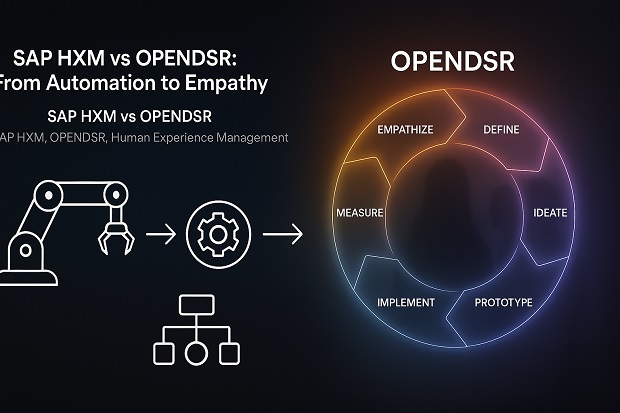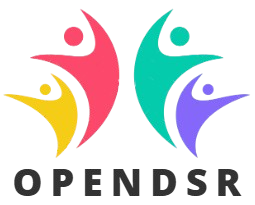
SAP HXM vs OPENDSR: From Automation to Empathy
SAP HXM vs OPENDSR: From Automation to Empathy
Introduction: The Evolution from Management to Experience
SAP’s Human Experience Management (HXM) framework redefined HR by moving beyond process automation toward understanding employee sentiment. Yet, even with its intelligent analytics and workflow automation, HXM often remains system-centered — interpreting people through data rather than designing from their lived experiences.
In contrast, OPENDSR (Observe, Prioritize, Envision, Navigate, Design, Systematize, Refine) begins where HXM leaves off — at the intersection of empathy and action. It reimagines employee experience not as a managed process, but as a living, adaptive ecosystem powered by human insight, real-time intelligence, and design thinking.
1. Understanding SAP HXM: From Systems to Sentiment
SAP introduced HXM to humanize its HR technology suite (SuccessFactors) and close the “experience gap” between what organizations think employees need and what they actually experience.
HXM brought forward a key philosophy:
“It’s not about managing employees, it’s about understanding them.”
However, in most implementations, this understanding remains quantitative — reliant on pulse surveys, sentiment analytics, and automated dashboards that provide descriptive insights, not design-driven transformation.
Aspect SAP HXM Key Limitation Core Purpose Automate and humanize HR processes Focused on sentiment, not co-creation Method Survey-based data and dashboards Reactive to feedback, lacks forward design Scope HR-driven (Talent, Payroll, Learning) Limited cross-functional empathy Technology Integrated SAP ecosystem High dependency on system adoption Outcome Employee insights and recommendations Action gap between insight and experience
SAP HXM thus diagnoses employee experiences, but often stops short of designing new experiences.
2. Introducing OPENDSR: The Human Operating System
OPENDSR transforms employee experience from a management layer to a human operating system.
Each of its seven steps — Observe, Prioritize, Envision, Navigate, Design, Systematize, Refine — guides leaders in turning empathy into structured transformation. Rather than treating feedback as data, OPENDSR treats it as dialogue.
OPENDSR Step Purpose Key EX Outcome Observe Listen deeply to human signals Empathy-based insight Prioritize Focus on what matters most Clarity of action Envision Co-create ideal experiences Shared ownership Navigate Build pathways of change Alignment and agility Design Prototype and test interventions Scalable innovation Systematize Integrate into workflow and systems Sustainable adoption Refine Continuously learn and evolve Adaptive EX culture
The result is a living EX system — continuously sensing, learning, and improving — unlike static survey or dashboard loops.
3. Comparing Philosophies: Automation vs. Empathy
While both SAP HXM and OPENDSR aim to humanize the workplace, their philosophical centers differ:
Dimension SAP HXM OPENDSR Design Logic System-led Human-led Core Driver Automation and integration Empathy and adaptation Feedback Flow Periodic and survey-based Continuous and signal-based Time Orientation Diagnostic (past-focused) Design (future-focused) Experience Level Organizational Individual and collective Change Mechanism Reports → Action Observation → Co-creation Mindset “Manage” people “Design” with people
In essence:
-
SAP HXM collects and manages experience data.
-
OPENDSR translates data into meaningful human change.
4. The Gap Between Insight and Action
Many organizations implementing SAP HXM experience a familiar frustration:
“We have great dashboards and data, but limited action.”
This insight-action gap emerges when empathy is translated into static reports instead of iterative design loops.
OPENDSR closes this gap by embedding real-time sensemaking within daily workflows. It shifts focus from what employees feel to how the organization responds — creating a feedback system that learns as it listens.
Bridging the Gap: Comparative Table Challenge in HXM How OPENDSR Solves It Data overload from multiple surveys Synthesizes signals into human stories Slow response cycles Real-time empathy loops Limited employee co-creation Co-design sessions embedded in Observe/Envision stages Lack of contextual relevance Designs experiences tied to local/team moments One-size-fits-all interventions Modular, adaptive templates Leadership disengagement Governance through EX roles (EX Owner, HCX Steward)
By design, OPENDSR ensures that every feedback point becomes an activation moment, not just a data point.
5. Case Example: Automation Meets Empathy in Practice Scenario: A Manufacturing Organization Using SAP HXM
The company had automated most HR processes — onboarding, payroll, performance reviews — via SAP. Engagement scores were stable but stagnant.
When they layered OPENDSR on top:
-
The Observe phase revealed employees felt unseen during digital onboarding.
-
Through Envision, HR and line managers co-designed micro-interactions — welcome calls, mentor pairing, empathy nudges.
-
The Systematize phase integrated these into SAP workflows, turning data touchpoints into human experience triggers.
Result:
Within one quarter, new-hire satisfaction rose by 27%, while HR response time to feedback dropped by 42%.
Interpretation:
Automation created efficiency. OPENDSR added emotion, ownership, and flow.
6. Structural Comparison: HXM Framework vs OPENDSR Cycle Category SAP HXM Framework OPENDSR Operating Cycle Core Modules Core HR, Payroll, Talent, Analytics Observe → Prioritize → Envision → Navigate → Design → Systematize → Refine Experience Lens Employee Lifecycle Human-Centered Lifecycle Data Type Operational + Experience (O-data + X-data) Quantitative + Qualitative + Emotional Signals Activation Mechanism Automated workflows Empathy-led interventions Learning Loop Periodic review Continuous refinement Tech Dependency SAP SuccessFactors suite Integrates across platforms (API-agnostic) Primary Outcome Process efficiency Sustained human experience improvement
While SAP builds intelligence around processes, OPENDSR builds consciousness within systems.
7. From Process Efficiency to Human Flow
SAP HXM simplifies workflows; OPENDSR enhances human flow.
Flow, in the OPENDSR context, means the effortless alignment between people, processes, and purpose. When empathy drives design, employees experience their work as coherent, responsive, and emotionally safe — not merely efficient.
Indicator HXM Impact OPENDSR Impact Efficiency ✅ High ✅ High Adaptability ⚪ Limited 🟢 Dynamic Emotional Resonance ⚪ Moderate 🟢 Strong Innovation Culture ⚪ Moderate 🟢 Strong Retention and Belonging ⚪ Data-led 🟢 Relationship-led Experience Continuity ⚪ Episodic 🟢 Continuous
By blending design thinking with operational governance, OPENDSR makes efficiency feel human.
8. Human Experience Design: From Metrics to Meaning
While SAP’s HXM quantifies engagement, OPENDSR qualifies meaningful connection.
The difference lies in what each system values:
-
HXM: “How do employees rate their experience?”
-
OPENDSR: “What stories do those experiences tell, and how do we redesign them?”
This subtle but powerful distinction makes OPENDSR a Human-Centered eXperience (HCX) framework — turning empathy into structure, structure into rhythm, and rhythm into culture.
9. Integration Potential: OPENDSR + SAP HXM
The frameworks are not rivals but complements. When integrated, they represent the best of both worlds:
-
SAP’s process intelligence
-
OPENDSR’s empathy intelligence
Combined Outcome Description Unified EX View Combine SAP data with OPENDSR signals for holistic visibility Experience Activation Translate survey findings into EX design actions Governance Layer Introduce roles like EX Owner or HCX Steward Real-Time Refinement Continuous feedback loops on top of SAP systems HCX Certification Upskill HR and managers on empathetic design cycles
This integration redefines digital HR transformation — from managing experiences to designing them in motion.
10. Leadership Implications: Governing with Empathy
To sustain OPENDSR within SAP ecosystems, leaders must adopt governance through empathy — shifting from command-and-control to listen-and-learn.
Roles like:
-
EX Owner (drives cross-functional human experience outcomes)
-
HCX Data Steward (ensures ethical and human data usage)
-
Moment Designer (curates emotionally resonant touchpoints)
These roles form the governance triad that turns technology into trusted experience infrastructure.
11. The Human OS Advantage Attribute Traditional HXM Systems OPENDSR Human OS Nature Digital platform Living ecosystem Center System intelligence Human intelligence Adaptation Speed Moderate Real-time Emotional Context Indirect Directly embedded Longevity Product-dependent Culture-dependent Core Currency Efficiency Empathy
OPENDSR redefines EX maturity not by how much technology an organization owns — but by how consciously it listens, learns, and evolves.
Conclusion: From Automation to Empathy
SAP HXM revolutionized HR technology. It gave organizations tools to measure and manage experiences. But in an age where employees seek meaning, not management, the next evolution is empathy.
OPENDSR is that evolution.
It’s not a replacement for HXM — it’s the human upgrade to it.
By infusing real-time empathy, adaptive design, and continuous refinement, OPENDSR completes what HXM began: turning automated workplaces into alive, aware, and adaptive human systems.
🔹 Key Takeaway Table HXM Strength OPENDSR Enhancement Efficient workflows Emotionally intelligent flow Centralized data Decentralized co-creation HR-driven processes Organization-wide ownership Periodic insight Continuous design cycle Dashboard reporting Human-centered redesign Final Thought:
“Automation makes work faster. Empathy makes work matter.”
Together, SAP HXM and OPENDSR create the foundation for a future where technology listens and humans lead.








